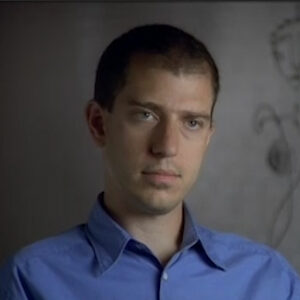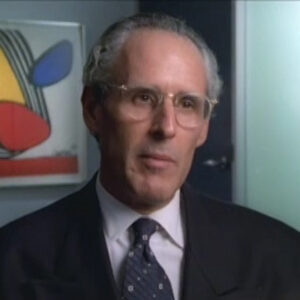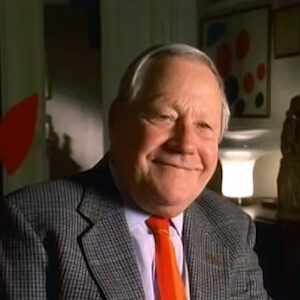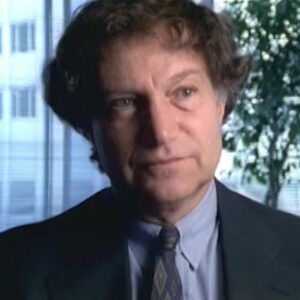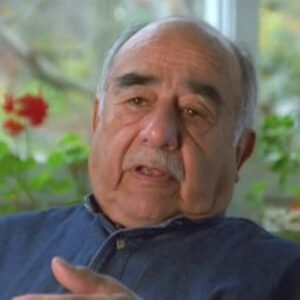Interviewer: Thank you for coming. Here’s the big question. Who was called up and why? Why should we care about Calder?
Mark Stevens: It’s like asking why is the sky blue? First question. Calder I think is very interesting as it as one of the few figures in the 20th century who really has a capacity for joy, who takes great pleasure in art and has a intoxicated, almost erotic relationship with the world. The other artists that we think of in the 20th century who have a joyful air about them, such as Mutis Romero, also have a dark aspect. You feel that they know about the darkness of life as well as the brightness. Calder doesn’t have that aspect. There’s, um, there’s, uh, no bear in the forest. He’s the bear. He’s the he’s the, uh, the teddy bear. So this is a very rare thing in, uh, in 20th century art, which is not very good at charm. sweetness. Those kinds of values.
Interviewer: Were just adjust quick. Still good with that Microphone. OK. Well, I can put it up. You’ve obviously seen hundreds, if not thousands of Calder sculptures. What’s what’s the experience of a Calder? What does it do for you if you see a particular piece or. What is what do you feel.
Mark Stevens: Well, in terms of the mobiles, uh, what I normally feel is that, uh, they’re half alive. Uh, they have, uh, whimsy and a spontaneity about them that you rarely find in art. It’s still, uh, they move slightly. They seemed to breathe. Uh, they’re not always in the same spot. In the same position. They have a butterfly, uh, whimsy about them. That, uh, is very unusual in art. Uh, there’ve been so many of them, so many museums have them floating here and there that I think it’s become hard to see them sometimes. Uh, you see one call, do you say, I know what Calder is? And you don’t look at it. But if you actually spend the time and relax and let yourself just play with the play of the form, uh, then I think, uh, it’s a very unusual, uh, gentle experience, uh, and very rare in in the 20th century to find that kind of, uh, experience.
Interviewer: This is sort of a question that I was going to ask much later, but it follows pretty well right now. Do you think he was very repetitive. I mean, he did do some work. You said that. If you don’t really take a look.
Mark Stevens: Well, most artists are repetitive. Most of us only have one or two good ideas. And Caulder had at least one very good one. And he then.
Interviewer: Cut for a second. Can you talk about sculpture, static versus non static motion? Random motion, is that was that a new thing?
Mark Stevens: That’s a very hard question. The 20th century is a century full of movement. And so it was a natural idea, really, for an artist to decide sculpture should move too. We have movies. We have busy cities. We have the jostle of urban life. Shouldn’t sculpture also move? Aren’t we making a mistake? If sculpture stays still. So, uh, Calder’s idea of animating sculpture certainly fits the spirit of the time.
Interviewer: OK. You’ve talked about his respect and his lack of respect. Can you tell me about that? You said overrated and underrated. Can you go into that.
Mark Stevens: Calder is both overrated and underrated. He’s a underrated by people. Serious people in the art world. I would say, who are tired of the cute teddy bear image of Calder. Calder, is also a person who people who don’t like modern art like. And I think that irritates those who really do like the whole depth and endeavor of modern art. He’s been oversold. He’s been overpraise. He’s been made too cute by half. So there’s been a natural resistance to him on that basis, although people haven’t very often written against him. They simply just don’t pay much attention to him. Many serious critics don’t. On the other hand, he’s been. I’m getting confused here, but he’s he’s overrated. And in a serious way, I think also in that in that he’s very limited. I mean, Jane Austen once said that Pride and Prejudice, a charming book, wanted shade. And that’s a serious artist talking. That’s an artist who knows that there’s a darkness in life, especially in 20th century, and that if you’re going to be an ambitious artist, you need to include at least some of those shadows. Calder really doesn’t have any shadows or very, very few shadows. And that maybe that’s the source of his charm, his childlike quality, the sensation of the eternal trial that hangs about his work. But it’s also a limitation. It means that that there’s an awful lot of human existence in the 20th century that he hasn’t addressed or confronted, that perhaps he’s made it a little easy for himself by not admitting any shadows and into his universe. On the other hand, would you want shadows in Calder. No. The charm is that exactly that, that. That it’s so fresh and free.
Interviewer: So. It’s it’s interesting after saying that you do want it, then you’re saying you don’t want it. So what does that leave us with?
Mark Stevens: Art, Calder is exactly who he is. He’s he’s unafraid. He’s not trying to be somebody else. He is who he is. And that’s that has a kind of sturdiness about it. A strength, again, a kind of bear like quality. And you can take it or leave it. But it’s he added something that wasn’t there before. He’s once, you know, about him and his work, it immediately has an almost geographical place or a position in in your universe of who you like, what you’re interested in, whether that geographical position, whether that intrinsic tough sense of self that he had is an important part of your universe is up to you. If you happen to think that that art ought to think about the shadows of life a bit, then perhaps Calder will be a vacation or a smallish part. But he’ll always be there because that desire that people have. It’s a desire for paradise really is met by Calder. And he he creates a world in which there is no evil. And that’s a very appealing idea and a profound idea in its way. It’s an idea that the human cultures have had from the start and very few people of intelligence in the 20th century have been able to to sustain or buy into that kind of world view. Calder is one of the very few who does so without seeming merely corny or sentimental, without seeming to be running away from the world. He’s just who he is. He’s a great, eccentric.
Interviewer: This childlike sensibility that everyone talks about. Do you think that. Sometimes takes away from him that people consider him less serious. Doesn’t mean he’s not a serious artist.
Mark Stevens: No, that desire for a childlike universe is an eternal human thing and an important one, which he serves and addresses and embodies to a marvelous degree. There are many other aspects of the love of art and of the human situation that Calder simply does not address. So it all depends. I mean, he if he has his wonderful spot, whether that spot should and should be inflated to be a great big master artist or not. That’s up to you. I mean, I think it’s I think he’s a he’s an eccentric artist .Judgment. You know, Judge, when you try to judge Calder, you immediately feel prudish and ungenerous because it’s like saying you don’t like a teddy bear. You you. Why would you. Why would you even choose to judge? But if you have to if you have to be a sour critic, I would say that he’s a he’s a marvelous small artist.
Interviewer: Let’s cut from one second, please. He went to Paris in twenty six. What was going on in Paris? Who was there? Why would one go Paris?
Mark Stevens: Well, for artists and writers to of course, Fitzgerald and Hemingway went to Paris in the 20s.
Interviewer: What was happening in Paris? Why would somebody want to go.
Mark Stevens: American artists in the 20s, ambitious young artists who wanted to be where the action was to escape what was felt to be the provincial, cloying character of American life. In those days for artists, anyway, I went to Paris as fast as they could. That was where the most interesting artists were. They thought that was where the new was happening. And American artists in the 20s wanted also to be new. They knew they had something. They knew that America had its own voice. But perhaps that voice ought to be challenged and enriched by confronting the best that the old world had to offer. So it was a natural thing for an ambitious young artist to go to Paris to go adventuring in search of his own style. That was what many, many young people in those days did.
Interviewer: So he went and he started doing some woodcarving, searching. OK. OK. What was he doing in those early days? And how did he do?
Mark Stevens: The wooden sculpture. I like quite a lot, but it’s still. He’s an artist who’s looking for his material, not just his vision, but his material. A sculptor has many choices and needs to explore the tangible, physical nature of the world to find which material suits his temperament. Wood I think for Calder was somewhat intractable, difficult, perhaps had a little bit too much of his of its own character. He didn’t have enough air. Wood is a is a is a is a difficult, laborious material to work. I think he wanted a more whimsical, lighter material. And of course, wire allows allows him to sort of draw with a with metal and to bring air and light and a gracious, graceful, witty note to sculpture. Wood has too much of its own character.
Interviewer: I think so he. He starts to work in wire and he makes toys and he makes starts to make animals and which leads us to the circus. Can you talk about. How how you react to that early stuff?
Mark Stevens: I think his circus and the toys and the animals are among his best work. Perhaps because he’s not straining there. They are absolutely, uh, without pretension, without that kind of sweat. That sometimes comes into art when the artist is trying to be big and important and ambitious. Values that don’t really serve Calder very well anyway, since he’s an unpretentious man, an artist. The toys and the animals really look like works that are done for his own pleasure, for his own joyful, his own joy that he takes in in a comical character of animals. And in the circus, the circus, you know, in the in the early part of this century and the latter part of the 19th century was a great symbol for many artists. But many artists also saw in the circus a kind of dark expressionist note. Circus was a place of masks and of unconscious desires, appearing. Calder actually liked the circus for being a circus, for being fun, for being childlike, for being whimsical. Those values enter other art, too. That’s about the circus. But the again, once more they should have said that. But the the the the the dark aspect of the circus does not enter into Calder’s view of the institution. He just thinks it’s a place of play. The circus is what life should be. We should all be acrobats. Trapeze artists, clowns. We should play with animals. Animals should talk to us and perform for us. We should perform for animals. We should make children happy. He really, uh, takes very seriously the idea of the circus as a version of paradise.
Interviewer: Can you can you tell us why this became hot night out in Paris? Why circus critics came and reviewed it? I mean, it was really performance art. Maybe you could talk about.
Mark Stevens: Well, once again, I think the idea of performing a performance was very witty, very French. The idea of of, uh, making a tiny little intimate circus and then having a clown like bearlike figure perform this circus had a, uh, just a great charm. And of course, the French are masters of charm. They understand charm, perhaps, uh, better than any other people in the world. And, uh, what could be more charming than a, uh, a teddy bear of a man? Uh, performing a circus that he made with his own hands in small.
Interviewer: Is this serious art or does it matter?
Mark Stevens: The question about whether it’s serious is not finally interesting? Yes. Joy is serious. Pleasure is serious. The desire for a child like universe is serious. It doesn’t include many important elements that art must and has and always has and always will address. But, yes, I think the desire for a childlike universe can be serious.
Interviewer: Talk about the intricacy. Let’s talk about wireportraits and what you felt about the wire portraits. And I’d like to hear you. I don’t. You probably remember that many of his wider portraits were may have one piece of wire. Hear your reaction to that intricacy.
Mark Stevens: Because many of his wire, uh, pictures of animals, uh, in particular, are made up of a simple single strand of wire. I think it implies to people that everything is connected, that you don’t have to take disparate pieces, that the world is not made of pieces. You can just go like this and the animal will appear. It’s an image of ease and fluency. Uh, that very subtly serves his, uh, his larger view that life should be, uh, a kind of paradise, uh, a kind of circus, a childish place. Uh, a child would want to take one. It’s like a, uh, it’s like, uh, the one of the sparklers that you do in the air like this and you make a drawing in the air and it’s everything is connected and then it’s gone. There’s that kind of ease in in the way he uses a single wire. It’s also a wonderful thing to see an intractable material, a difficult resisting sort of material like wire that, you know, has its own spine and its own strength and its own point of view in a way, to see that kind of material yield to whimsy. The implication of that is that the world itself, which is often intractable, difficult, tense, can also yield whimsy. So when Calder makes his wires dance, as it were, uh, somewhere in ourselves, we think, well, perhaps the world itself can be made to dance in that way. Now, we may think, upon reflection, that’s not true, but for a moment anyway.
Interviewer: Do you know about his development into the abstract style? Because that’s something we can. Did for just in Dacres, that became one. Can you comment on how he developed?
Mark Stevens: I don’t think I necessarily have to have a informed opinion on that. I mean, I think that the the abstraction is a natural evolution in his work, though. It’s a it’s an example of an artist trying not to repeat himself. It’s admirable that he didn’t go on making delightful circuses and toys all his life, but continue to press himself to find an abstract form. Abstraction for Calder, I think was a way to try to make his his sensation of of play in a way more profound, more serious, to not limit it to a descriptive quality. But to say that at the heart of things in the abstract heart before things actually take a form, before the kangaroo, before the elephant, before the cow, there is a kind of whimsy that’s universal. So the abstract, I think, helps convey that idea.
Interviewer: Do you think he might have have taken himself more serious? I think there was maybe he wasn’t didn’t see himself serious as a serious artist until that time. What do you think there was a change in him?
Mark Stevens: Again, I don’t know much about Calder’s personal life or point of view, but I would doubt very much that he didn’t take himself seriously. You cannot make art even of the most joyful or seemingly simple kind in the 20th century without being very serious about it.
Interviewer: I was knocked out to learn that this ubiquitous thing of mobiles was actually invented by a person. There was other kinetic art, but I thought it came from ancient Egypt and Mesopotamia. Do you have a feeling about that, this thing that we now see everywhere in every child’s crib came from a person?
Mark Stevens: Well, if you’re interested in art history and the way things move and art and evolve and develop, there is a kind of wonderful passage from Miro, say, and Mondrian and into Calder, because the implication of Miro and particularly in particular and of surrealism in general was that form should move that whimsy. And the unexpected conjunction of elements is very important, that the unplanned is essential, that mistakes can be useful. That surprises is the essence of art. All that was was inherent in surrealism and in in an artist like Miro. So Calder did take it now seems obvious. But the wonderful next step, which is to say, well, if surprise and movement and the unexpected conjunction of elements is important, why not literally do that? Why not let those Miro’s shapes jump out of their frozen canvas and play the way they so manifestly want to play? Let them let them do their dance. Literally, not just metaphorically. So it’s a very it’s a it’s a it’s quite a wonderful step that he took.
Interviewer: Would you say he singlehandedly invented an art form?
Mark Stevens: So I think all that is. That’s for our historians and for the clerks of the industry who like to put things in boxes. It’s very exciting initially when someone has a new idea like that. But finally, what you want to ask is how good is the work? How interesting is it? Does it really continue to live simply the invention of something new? Well, that’s just novelty. That aspect, I don’t think is is really why why we pay attention to Caulder. I don’t think it’s because he had a he invented a new art form. I think that’s. Oh, that’s mostly advertising.
Interviewer: OK. We need to cut for a second. This shock that he calls it this moment in your dance studio, that was very, very important to you. Can you relate the importance of that?
Mark Stevens: One of the interesting aspects of his visit to Mondrian Studio is his fascination and interest in an environment in which art seems to have taken over the entire situation, the entire space in which art is not something that’s just hung on the wall, but something that is in every nook and cranny. That implies that art can become far more significant and powerful in our lives, that it’s not simply a matter of taking your little head at the museum on a weekend that it can inform our environment and the way we live in a more fundamental way. And you can see after the visit to Mondrian studio that Calder really, for the rest of his life, is deeply involved with the idea of making environments for himself, not just making a circus environment anymore, but but making a house, making his spoons, making his cups, living a way in which art informs every decision, every moment of your life and existence.
Interviewer: Let’s jump into the mobiles, which he fairly quickly started working, and you have. Does he push his own form? Does he continue to evolve? What do you think drove him?
Mark Stevens: The early mobiles to me are still very influenced by surrealism. They say. There’s one I think called Spider that that really looks like a spider. And part of the pleasure of it is to it’s an abstract form, but it’s to see the spider in. In the form in the way he did the form. It looks like a web. You can see it has a sort of shimmer. And you think Spider is not a marvelous, essential version of of a spider. Later, he begins to, I think, be less patient with the idea of of description, as if that, too, could finally limit him. So they the mobiles, I think, move from a more descriptive surrealist temper to one that is genuinely more abstract and that can’t be limited in any way, shape or form.
Interviewer: Let’s let’s talk about stabiles. Is that an interesting form? Is it an invention?
Mark Stevens: I wouldn’t call it an invention. Stop yields there, there to me, they they look like dinosaurs that aren’t dangerous. They have crabs that are that are witty. They they don’t. They’re they’re monumental forms that are not overweening or aggressive. They don’t have the sort of the usual macho of public sculpture. And they also have an implied movement about them. For some reason, they have the arches. You know, an arch is a form that’s both very strong, but also has a lot of air in it. That’s why. Why? Why church makers are so interested in arches. So the stabiles are not all that stable, I’d say, and they’re just as whimsical in their way as the as the mobiles. Finally, they’re probably not quite as interesting either because they don’t move.
Interviewer: How about the guoaches?
Mark Stevens: Can’t stand them. There like third rate Miro. I mean, don’t use that, but there, there, there. There you see an artist who is just. That that work to me really looks quite trivial.
Interviewer: Talk about the success of the stabiles. You were saying monumental.
Mark Stevens: Well, both the mobiles and the star bills began small. He began. He began, as with everything, and called her as a kind of tinkering in a bicycle shop way on us on a smallish level. And they’re quite like his toys. You can see the connection. I like the small ones. I’d say as a rule, better than the large ones. I think they’re closer to his heart and to his natural way of working when they get blown up and made very large. I sometimes think that that’s not really in keeping with with Calder’s native sense of scale. On the other hand, when they do become monumental, both the mobiles and the stabiles, there is something that small and charming that they retain. That is, they don’t because they’re not they don’t become monuments that you’re suppose that are supposed to make you fill with all or that are supposed to overshadow you or make you think of heroic things. They retain a quality of childlike whimsy. And that is a that’s kind of a wonderful thing in our day and age where we have ridiculous structures like the World Trade Center dominating our skyline to have a monumental sculpture. That doesn’t seem to be about monumentality.
Interviewer: Do you want to talk about his reputation in the 40s, he had a MoMA show that really solidified him. Is that something that’s worth.
Mark Stevens: Well, I only in the context of his, which we talked about before, I really my point of view is he’s just both overrated and underrated. He’s overpraised and underpraised.
Interviewer: Talk about how France affected him. What did he bring to France and what did France bring to Calder?
Mark Stevens: I think France affected Calder in many different ways. The most obvious, of course, is that he met and got to know at firsthand European artists. But in a more subtle way, I think charm is is what he he got from France. He learned to respect and to value charm. Americans or American culture at that time didn’t have a strong place or a strong respect for sensual pleasure, for eating and for a charming look and for the kinds of things that that really intoxicate Calder so that an artist like Calder who who is about kind of whimsy and charm and grace, he wasn’t going to find much support for those sorts of values and in a Protestant America. And so to go to a Catholic, more easy living kind of country where there’s plenty of Gallic charm and wit, lots of wine also was exactly what what his sensibility needed.
Interviewer: And how did that was he then a French or an American?
Mark Stevens: He’s very much an American artist, I think. OK, well, he called us very much an American artist. He’s a tinkerer. He he seems self-taught. It’s as if he has a garage workshop attached to his house. He’s playful in an American way, but he found as justification for his Native American qualities or a deepening by going to France and experiencing the charm of that country. The sweetness, I think that brought a note of of unapologetic whimsy to his American tinkering.
Interviewer: Good. Do you think he was influenced by anyone?
Mark Stevens: Well, I think he was influenced by, uh, by many people, many artists, many moments, uh, I would say that Miro must be the great influence. He was probably also influenced into another kind of way by running away from his family background. More grand idea of sculpture. I mean, I think that his rebellion is that that he insists that. Well, perhaps I’m the the grandchild and child of sculptors. Well, I’m just gonna continue being a child. Is that right, by the way, that both his father and grandfather?
Interviewer: Perhaps ten generations before. What about his collaborations with other artists, Martha Graham, Eric T.. How does that hold up in this?
Mark Stevens: Because Calder was so interested in creating an entire environment as a work of art. He was a natural collaborator. He was, I think, and because he was not arrogant or pretentious, I think it was probably easier for him to work with other artists than it usually is. His ego would not necessarily get in the way the way it often does and collaborations. He because he loved the idea of circuses and performances, because art to him should be an environment. He was a natural collaborator.
Interviewer: How would you place him amongst 20th Century artists?
Mark Stevens: I think he has a the 20th century is such a tormented and difficult century that there has not been much art that takes seriously the idea of joy and pleasure and childlike qualities. There are there is, of course, a love of the child in surrealism, but often it has a darkness to it. Calder’s art is never dark. Whether that’s an interesting thing to have done in this particular century or not is another question. I think he has a secure but middling place in the art of our time. He’s an important.


